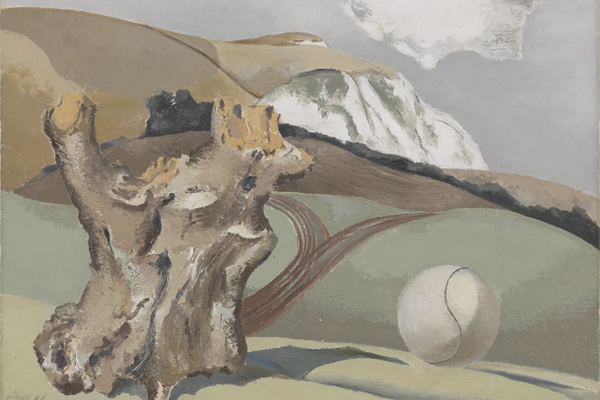Andrew Causey opens his book on a slightly defensive note: Paul Nash, he says
is often identified as Britain’s outstanding 20th-century landscape painter, as if painting the natural scene was the only thing he did, or landscape art as a genre is entirely separable from others, such as portraiture or history painting.
It is unexpected to find that at least among art historians the idea of landscape painting as a lesser genre still lingers. To the general public Paul Nash is as likely to be familiar as an official war artist of both world wars, author of one of the most indelible images of the Great War, ‘We are Making a New World’ (1918), with its splintered trees, cratered earth and blood-red clouds, and of the sea of wrecked German aircraft of ‘Totes Meer’ of 1946.
But of course it is true that unlike his brother John, Paul Nash used landscape as a vehicle for metaphysical matters beyond the recording of its beauty or of the personal emotions it aroused. He was after the great dramas and mysteries of existence and the perennially absorbing question of what happens to us when we die. He saw the cycle of birth, growth, death and renewal, the dramas of decay and survival, paralleled in landscape, in the cycle of the seasons, the travels of ‘the great luminaries’, the sun and moon, the battle between sea and land. And not being able to create human figures of a grandeur to sustain such subjects, he substituted objects, both natural and man-made, to play their parts. They became what Nash, in his 1937 essay ‘The Life of the Inanimate Object’, called ‘personages’.
Nash was a slow starter (amazingly only teaching himself oil-painting in 1918 in order to undertake large-scale commissions for the Imperial War Museum). His first ambition was to be a painter-poet like Rossetti or Blake, but his poetry was not up to scratch (‘verse equivalent to Dutch Elm Disease’ is how another commentator describes the poem he wrote to accompany a 1912 drawing of three trees). Trees, stones and water were the key elements of his imagery right from its somewhat wobbly symbolist beginnings. As Nash’s art developed, through international modernism and his own brand of surrealism, Causey shows how to interpret other emblems such as paths, birds, ladders, log-piles, fossils, flowers, serpents and much else. Although Nash saw himself as a ‘messenger’ and believed in art as propaganda, particularly in times of war, his imagery can be, as Causey puts it, ‘arcane and secretive’, as if he was ‘consciously setting puzzles for viewers’.
Causey identifies the literary origins of Nash’s ‘personal mythology’ from its beginnings in Blake and Rossetti, Yeats’s ‘natural magic’ and concept of ‘ancient wisdom’, through The Golden Bough — James Frazer’s anthology of folklore and legends — and the artist’s interest in oriental religions and Hindu fairytales. Later, Thomas Browne’s meditations on death and on geometry in nature, Urne Burial and The Garden of Cyrus, which he illustrated in 1932, and his discovery of the standing stones at Avebury and subsequent interest in archeological remains provided him with new inspirations.
The introduction (which it might be a good idea to leave until the end, since it deals with such difficult, not to say dubious, abstractions as whose ‘cultural property’ the landscape became with the romantic movement) argues Nash’s use of landscape was a development of romanticism. In his conclusion Causey sees Nash’s early symbolism and later surrealism as rooted in the English romantic movement. He touches on Nash’s personal life and circumstances as a source for his ideas and imagery, but neither biography nor stylistic analysis play much part in this book which, drawing on the latest scholarly speculation on the subject, takes us chronologically through the development of Nash’s artistic language.
As Causey wrote in his 1975 introduction to the Tate exhibition of Nash’s work, ‘access to his often complicated forms of expression is only slowly won’; but in this book he provides us with a scholarly and absorbing elucidation of the artist’s mysterious and powerful images.






Comments